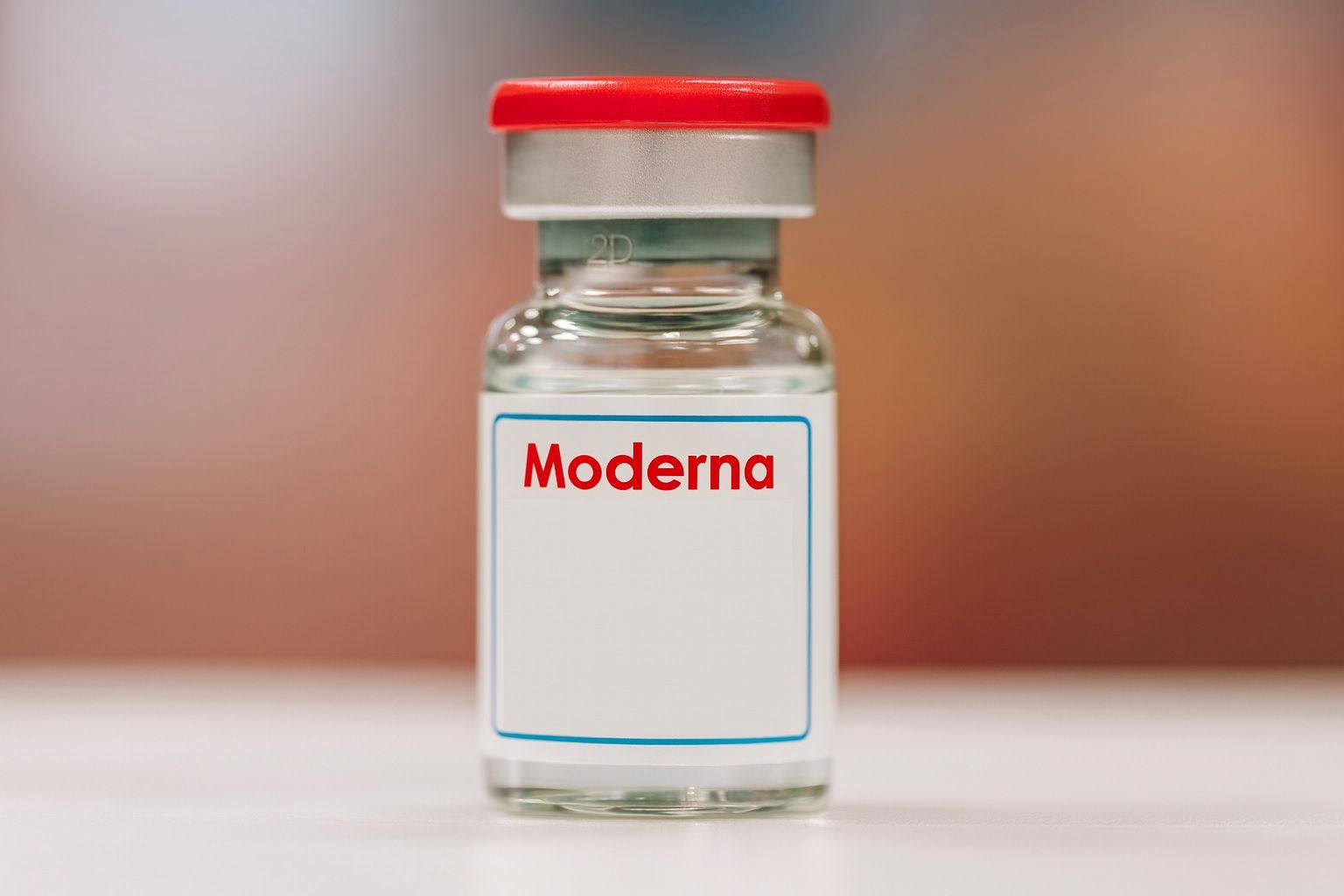- Stock Jumps, Still Deep in Red: Moderna’s stock traded around $28 on Oct. 16 after surging ~5% in the prior session [1]. Even with this bounce, the shares remain down roughly 35% year-to-date and nearly 80% below their level a year ago [2], erasing most of the biotech’s pandemic-era gains. Heavy short interest (over 60 million shares short) has contributed to volatility, as any bullish news can trigger sharp rallies [3].
- COVID Sales Collapse: After peaking at $18.9 billion in 2022, Moderna’s annual sales have plunged to ~$3.1 billion over the past 12 months [4]. Demand for COVID vaccines has waned dramatically, and regulators in the U.S. and Europe have limited Moderna’s updated booster shots to seniors 65+ and high-risk groups under 65 [5]. While Moderna’s next-gen mNEXSPIKE booster won approval for high-risk adults [6], the narrow eligibility means significantly lower near-term revenue potential [7].
- New Vaccine Data: Moderna is hustling to diversify beyond COVID with new products. This week it unveiled early data from an experimental cancer vaccine, mRNA-4359, showing a 24% tumor response rate in advanced melanoma patients (60% achieved disease control) and an impressive 67% response in a subset of patients whose tumors expressed a key protein [8]. Moderna’s oncology head, Dr. Kyle Holen, called the melanoma results “incredibly promising” for patients who had failed prior immunotherapy [9]. The data – presented at Europe’s ESMO cancer conference – suggest mRNA therapies could help overcome resistance in cancer treatment.
- Financial Strains:Quarterly revenue has collapsed – Moderna reported just $142 million in Q2 2025 sales (down 41% year-on-year), resulting in a $0.8 billion net loss for the quarter [10]. With COVID shot uptake falling, management slashed its full-year 2025 revenue forecast to $1.5–2.2 billion (down from $6–8B guidance given in early 2023) [11]. The company is cutting ~10% of its workforce to rein in costs [12] and burning cash – on track to spend about $3 billion this year [13] – though it still had around $10B in cash reserves. Q3 earnings are due on Nov. 6, and investors are bracing for another steep loss as Moderna transitions beyond its COVID windfall.
- Analyst Divergence: Wall Street is sharply divided on Moderna’s outlook. Some bullish analysts maintain lofty 12-month price targets above $200 [14], betting that Moderna’s pipeline will eventually bear fruit. Others remain deeply skeptical – Leerink Partners just reaffirmed an Underperform rating with a mere $16 price target (roughly 40% below current prices). Consensus estimates hover around $40–50, but targets range wildly from $15 up to $198 [15], reflecting uncertainty about Moderna’s post-pandemic earnings power. One TS2.Tech analysis warned Moderna could become a “one-hit wonder” if it fails to generate significant revenue beyond COVID vaccines [16].
- Pipeline & Partnerships: Moderna is leaning on new partnerships and products to reignite growth. Its personalized cancer vaccine with Merck (mRNA-4157/V940) – a Phase 3 trial effort – reduced the risk of melanoma recurrence or death by about 50% in an earlier study when combined with Merck’s Keytruda [17] [18]. Regulators are watching closely, as approval of this immunotherapy (which targets patient-specific tumor markers) could open a lucrative new market. Beyond oncology, Moderna launched an RSV vaccine (mRESVIA) for older adults and is developing combined respiratory vaccines. The company also opened a new mRNA Innovation and Technology Center in the UK this month, as part of a 10-year partnership with the British government [19]. The high-tech Oxfordshire facility can produce up to 250 million vaccine doses a year in a pandemic scenario [20] [21], underscoring Moderna’s push to expand its vaccine platform for seasonal flu, RSV, and future outbreaks.
Stock Rebounds on Moderna’s “Make-or-Break” Week
Moderna’s stock is back in the spotlight after a turbulent week of news that sent the Nasdaq-listed shares swinging. On Wednesday, MRNA jumped over 5%, climbing to around $27.7 by market close [22]. The mini-rally came amid a flurry of developments – from upbeat trial data on a new cancer vaccine to analysts debating whether Moderna’s future is bright or bleak. Even after the pop, however, Moderna’s stock is a shadow of its former self: shares have cratered roughly 80% below last year’s levels [23] and are down one-third in 2025 alone. The once high-flying biotech – which briefly surpassed $170 billion in market value during the COVID vaccine euphoria – is now hovering near multi-year lows, with a market cap around $10–11 billion [24].
The extreme volatility reflects investors’ split views on Moderna’s trajectory. Short sellers have piled in, with over 60 million shares sold short (about 15% of the float) – a massive bearish bet [25]. This makes the stock prone to short squeezes: any hint of positive news can force skeptics to buy back shares, spiking the price. Indeed, some traders believe Moderna may have hit bottom after sliding to $23.15, its lowest point in a year [26]. “The sell-off in Moderna stock simply looks overdone,” wrote MarketBeat, noting that even modest good news on boosters or the pipeline can fuel relief rallies [27]. Still, with the stock whipsawing between hope and fear, it’s clear that sentiment remains fragile.
COVID Vaccine Demand: From Blockbuster to Bust
Central to Moderna’s woes is the rapid collapse in COVID-19 vaccine sales. Just two years ago, Moderna was riding high on its Spikevax COVID shot, which became one of the world’s top-selling vaccines. The company’s revenue peaked near $19 billion in 2022 [28] – an astounding windfall for a firm that had never sold a product before the pandemic. Fast-forward to late 2025, and the picture has flipped. In the past year, Moderna’s sales shrank to about $3 billion [29], while expenses remained heavy. The company lost roughly $3.3 billion on an operating basis in the last 12 months [30], illustrating how quickly the COVID cash cow has dried up.
Multiple factors have hammered COVID vaccine revenue. Falling demand is one: most people have received initial vaccinations, and booster uptake has been tepid. Moreover, health authorities have narrowed recommendations for additional shots. In the U.S., regulators this fall approved Moderna’s updated booster (targeting newer Omicron strains) only for adults 65 and over and high-risk individuals under 65 [31]. This effectively excludes the broad healthy adult population from booster campaigns, a stark change from the blanket recommendations of prior years. Europe took a similar stance, limiting boosters to vulnerable groups. “The narrow market reduces near‑term revenue potential,” TS2.tech noted dryly [32]. In other words, Moderna’s latest COVID vaccines may be scientifically successful – a next-generation shot called mNEXSPIKE won U.S. approval in May for high-risk adults [33] – but they won’t move the needle financially if only a small fraction of people are eligible (and willing) to get them.
New data suggests the updated vaccines work well, at least in boosting immunity for those who receive them. Moderna reported that its 2025–26 formula mNEXSPIKE shot triggered a >16-fold rise in neutralizing antibodies against a prevalent variant in older and at-risk individuals [34]. An FDA-required study showed last year’s boosters led to fewer hospitalizations in vaccinated people [35]. Yet such news has done little to revive sales. Vaccine fatigue and skepticism have taken hold in the public – a challenge compounded by political signals. (Notably, U.S. health policy shifted in 2025 with authorities ending universal COVID vaccine recommendations [36], emphasizing personal choice for most and feeding perceptions that boosters aren’t necessary for all.)
As COVID product revenue craters, Moderna is essentially burning cash to invest in its future. The company still spends aggressively on R&D (over $700 million last quarter) but has begun belt-tightening elsewhere. In a bid to cut costs, Moderna recently announced a 10% reduction in its workforce, aiming to have under 5,000 employees by year-end [37]. It’s a notable pullback for a biotech that scaled up rapidly during the pandemic. Executives say these cuts, along with other savings, will help extend Moderna’s cash runway until new products (hopefully) start generating income. At the current trajectory, Moderna’s cash pile – about $9–10 billion – could shrink to roughly $6 billion by end of 2025 if losses continue at the present rate [38]. That gives the company a buffer of a couple of years to turn the ship around.
Bright Spot: Promising Cancer Vaccine Results
If there’s one thing keeping investors excited about Moderna, it’s the potential of the company’s mRNA pipeline beyond COVID. This week brought a tangible sign of progress on that front. Moderna announced encouraging early results from an investigational cancer vaccine codenamed mRNA-4359, which is being tested in patients with advanced melanoma. In a Phase 1/2 trial, when this mRNA therapeutic was combined with Merck’s immunotherapy Keytruda, it achieved a 24% objective response rate – meaning nearly a quarter of patients saw their tumors shrink significantly [39]. Importantly, these were patients who had already failed prior checkpoint inhibitor treatments, a tough-to-treat group. Among a subset of patients whose tumors expressed the PD-L1 protein, the response rate jumped to 67% [40], suggesting the vaccine might work especially well in biomarker-positive cases.
While the trial is early (and will continue into 2032), experts are cautiously optimistic. “Today’s mRNA-4359 melanoma data in highly refractory patients are unique in the field and incredibly promising,” said Dr. Kyle Holen, Moderna’s Head of Therapeutics and Oncology [41]. He explained that unlike traditional immunotherapies which reactivate existing T-cells, mRNA-4359 is designed to encode two critical immune escape pathways, potentially generating new T-cells targeted at the cancer [42]. In plain English, the vaccine teaches the body to recognize cancer cells that previously evaded the immune system. An independent oncology expert, Dr. David Pinato of Imperial College London, noted the “clear need” for better options in post-immunotherapy melanoma and said mRNA-4359’s approach “has the potential to rebalance the tumor microenvironment” to overcome resistance [43]. These are early-days endorsements, but they underscore the enthusiasm around Moderna’s use of mRNA technology in cancer.
Moderna presented the mRNA-4359 findings at the ESMO 2025 oncology conference in Spain, and the news helped remind investors that Moderna is “not just a COVID play.” The company is also advancing a high-profile personalized cancer vaccine (mRNA-4157/V940) in partnership with Merck. That custom-made vaccine, tailored to individual tumor mutations, reduced the risk of melanoma recurrence or death by 44–49% in a Phase 2 trial when paired with Keytruda [44] [45]. It’s now in Phase 3 testing across several cancer types [46]. If eventually approved, the Merck-Moderna cancer shot could be a game-changer – analysts note that if it ever reaches, say, $5 billion in annual sales, Moderna’s share of that would exceed the company’s entire current market cap at typical biotech valuations [47]. Of course, that is a long way off and far from guaranteed. But for investors, these developments are glimmers of hope that Moderna’s mRNA expertise can translate into new blockbuster therapies (and revenue streams) in oncology, infectious disease, and beyond.
Financial Results: Bleak Present vs. Future Bets
Moderna’s latest financial report lays out the steep challenges the company faces in the near term. In the second quarter of 2025, Moderna’s revenue plunged 94% from the same quarter two years prior (at the height of vaccine sales). Q2 2025 revenue came in at a mere $142 million – down 41% year-on-year even compared to Q2 2024 [48]. For context, that’s roughly what Moderna used to book in two days of vaccine sales back in 2021. The collapse in COVID vaccine demand has turned the company deeply loss-making: Moderna posted a net loss of $0.8 billion for Q2 [49], its third straight quarterly loss. Gross margins have evaporated as fixed costs far exceed the trickle of vaccine revenue.
In response, management cut its full-year outlook again. Moderna now expects only $1.5 to $2.2 billion in total revenue for 2025 [50] – a dramatic downgrade from the ~$7 billion it had initially guided for this year. The company also trimmed R&D and SG&A spending forecasts slightly [51], reflecting cost controls. Executives have acknowledged that 2025 and 2026 are likely to remain “investment years” with sizable losses, as the firm pours resources into new product trials (like flu, RSV, and CMV vaccines and multiple cancer programs) without much offsetting income. Moderna’s hope is that by 2027–2028, its next generation of mRNA vaccines and therapies will start to hit the market and replenish its revenue, including combination respiratory shots (COVID/flu/RSV), cancer treatments, and rare disease drugs.
Despite the red ink, Moderna’s balance sheet gives it some runway. The company entered Q3 with around $10.5 billion in cash and investments [52], thanks to its past vaccine profits. It carries no debt. This war chest is funding more than a dozen late-stage clinical trials concurrently – an unusually large pipeline for a biotech of Moderna’s size. But the cash burn is significant. As noted, 2025’s operations could consume on the order of $3 billion if revenue doesn’t pick up [53]. If needed, Moderna could also seek partnerships or licensing deals for some of its programs to bring in cash. Already, it has signaled interest in mergers and acquisitions (either as buyer or even a seller, if its valuation stays depressed) to complement its platform.
Investors will get a closer look at Moderna’s finances and product updates when the company reports Q3 2025 earnings on November 6. Analysts expect another large loss on a few hundred million dollars of revenue (Q3 is typically a bit higher with fall booster orders). All eyes will be on Moderna’s guidance for 2026: can they stabilize COVID/Spikevax sales at a baseline level, and how much advance purchase interest is there in the new shots (like the combo vaccines)? Moderna’s CEO Stéphane Bancel may also provide clarity on the company’s cost-cutting plans and how the firm is prioritizing its many R&D programs to conserve cash. Any positive surprises – for instance, signs of uptake for the new mNEXSPIKE booster among seniors, or faster regulatory timelines for a key pipeline product – could lift the stock. Conversely, another quarter of slow vaccine sales and high cash burn might reinforce the bear case.
Experts Split: Miracle Comeback or “One-Hit Wonder”?
With such a stark contrast between long-term potential and short-term struggles, it’s no wonder analysts and experts are split on Moderna’s stock. Optimists argue the current price is a bargain. By their view, Moderna transformed medicine once with its mRNA COVID vaccine, and it has the scientific talent and platform to do it again in other diseases. Multiple big banks reiterated buys on Moderna in recent months, highlighting the company’s strong cash position and pipeline breadth. For example, Brookline Capital maintained a lofty $198 target, calling Moderna’s latest COVID booster data “remarkably strong” in producing high antibody levels [54] [55] and suggesting the market is underestimating future demand. UBS analysts likewise kept a Buy rating and a $70 target, expressing confidence that public health policy will eventually normalize and that Moderna’s stock is oversold [56].
However, skeptics see a different story. Critics point out that Moderna has so far failed to diversify its revenue beyond the COVID franchise. “Moderna’s story hinges on COVID revenue” and the company has largely stuck to that niche rather than acquiring or developing non-mRNA businesses, noted a TS2.tech market report [57]. As a result, sales have collapsed with vaccine demand, and what remains is an R&D-heavy outfit with uncertain payoff. These analysts question whether Moderna’s pipeline can deliver commercial hits soon enough. Even promising vaccines for cancer or RSV will take years to reach the market and then still face clinical, regulatory, and market adoption hurdles. In the meantime, Moderna could bleed cash and perhaps require additional funding by the late 2020s. It’s a classic biotech conundrum – today’s valuation is built on future dreams, and if those dreams falter, the downside is large. Just this month, SVB Leerink (a pharma-focused investment bank) underscored the bear case by cutting its target to $16 per share, an almost throwaway valuation that implies little confidence in a quick turnaround. The Motley Fool went so far as to label Moderna a potential “one-hit wonder”, comparing it to biotech firms that soared on a single product and then faded.
Even some encouraging developments come with caveats. For instance, the much-hyped Merck collaboration on the personalized cancer vaccine, while undoubtedly a bright spot, is also sometimes cited as evidence that Moderna might be more valuable in someone else’s hands. A Reuters Breakingviews analysis argued that Moderna’s shrunken market value and rich pipeline make it a plausible takeover target for a big pharmaceutical company – perhaps even Merck itself [58] [59]. Merck faces a 2028 patent cliff for Keytruda, and buying Moderna could secure a pipeline of next-gen products, the column noted. However, political headwinds (a U.S. administration that’s lukewarm on vaccines) and Moderna’s own defenses against hostile takeovers make any deal speculative [60]. The fact that such M&A chatter exists highlights how dramatically Moderna’s standing has fallen: rather than the hunter, it’s now viewed by some as the hunted.
For now, Moderna’s management insists the company will emerge from this downturn stronger. They point to ongoing initiatives like the UK partnership, which just bore fruit with the opening of Moderna’s new mRNA manufacturing center in Oxfordshire. The facility can produce hundreds of millions of doses annually and will focus on vaccines for flu, RSV, COVID, and even cancer research, in collaboration with British health agencies [61] [62]. “It’s the chance for new treatments that save lives, and new products that drive growth and job creation,” said UK Science Minister Lord Vallance at the center’s opening, praising Moderna’s investment as a boon to the UK’s life sciences sector [63]. Such partnerships not only expand Moderna’s global footprint but also share the financial burden of R&D and manufacturing.
Outlook: Cautious Optimism or More Pain Ahead?
The next few weeks will be critical in determining whether Moderna’s stock can sustain its recent rebound or if another slide is in store. Broadly, the biotech sector has been under pressure – the SPDR Biotech ETF is down about 25% from its 2020 levels [64] – as rising interest rates and investor risk aversion hit unprofitable research-heavy companies. Moderna is no exception; its current valuation (~4 times next year’s expected sales) [65] is modest for a biotech, but reflects low confidence in near-term growth.
To change the narrative, Moderna likely needs to deliver tangible wins in the coming quarters. That could include securing regulatory approvals for new products (for example, its next-gen flu vaccine results are expected soon), signing new partnerships or contracts (perhaps a government stockpile order for its vaccines), or showing evidence that one of its many clinical trials is ahead of schedule or exceeding expectations. Investor focus is also on guidance: if Moderna can forecast even, say, $4–5 billion in revenue by 2027 from its combined portfolio, that might restore some faith that the company will eventually earn its high R&D spending.
In the meantime, expect the stock to remain a rollercoaster.Positive headlines – like the encouraging cancer vaccine data – will spur bursts of buying, while any disappointments or delays could send shares reeling again. The debate around Moderna encapsulates a larger question: Can a post-pandemic Moderna reinvent itself as a sustainable, multiproduct biotech giant, or was its COVID vaccine success a one-off event? As TS2.tech succinctly put it, “If Moderna can’t translate pipeline progress into meaningful revenue, it risks being a one-hit wonder.” [66] That makes the coming year pivotal. With nearly a dozen shots on goal in the form of different vaccines and therapeutics in trials, Moderna has ample opportunities to prove the doubters wrong – but until it scores a clear victory beyond COVID, investors may continue to approach this stock with a mix of excitement and caution.
Sources:
- TS2.Tech – Stock Update on Moderna (Oct 8, 2025) [67] [68] [69] [70]
- Reuters – Moderna’s Booster Restrictions & Approvals [71]; Breakingviews on Moderna’s Valuation [72] [73]
- MarketBeat – Moderna Stock Performance & Short Interest [74] [75] [76]
- Investing.com – Analyst Commentary on Vaccine Data [77] [78]
- Targeted Oncology – mRNA-4359 Cancer Vaccine Trial Results [79] [80]
- PathologyInPractice – Moderna’s UK mRNA Facility Partnership [81] [82]
References
1. www.marketbeat.com, 2. www.marketbeat.com, 3. www.marketbeat.com, 4. ts2.tech, 5. ts2.tech, 6. ts2.tech, 7. ts2.tech, 8. www.targetedonc.com, 9. www.targetedonc.com, 10. ts2.tech, 11. ts2.tech, 12. www.breakingviews.com, 13. www.breakingviews.com, 14. ts2.tech, 15. www.investing.com, 16. ts2.tech, 17. ts2.tech, 18. www.breakingviews.com, 19. www.pathologyinpractice.com, 20. www.pathologyinpractice.com, 21. www.pathologyinpractice.com, 22. www.marketbeat.com, 23. www.marketbeat.com, 24. ts2.tech, 25. www.marketbeat.com, 26. www.marketbeat.com, 27. www.marketbeat.com, 28. ts2.tech, 29. ts2.tech, 30. ts2.tech, 31. ts2.tech, 32. ts2.tech, 33. ts2.tech, 34. ts2.tech, 35. www.reuters.com, 36. www.investing.com, 37. www.breakingviews.com, 38. www.breakingviews.com, 39. www.targetedonc.com, 40. www.targetedonc.com, 41. www.targetedonc.com, 42. www.targetedonc.com, 43. www.targetedonc.com, 44. ts2.tech, 45. www.breakingviews.com, 46. ts2.tech, 47. www.breakingviews.com, 48. ts2.tech, 49. ts2.tech, 50. ts2.tech, 51. ts2.tech, 52. www.breakingviews.com, 53. www.breakingviews.com, 54. www.investing.com, 55. www.investing.com, 56. www.investing.com, 57. ts2.tech, 58. www.breakingviews.com, 59. www.breakingviews.com, 60. www.breakingviews.com, 61. www.pathologyinpractice.com, 62. www.pathologyinpractice.com, 63. www.pathologyinpractice.com, 64. www.breakingviews.com, 65. www.breakingviews.com, 66. ts2.tech, 67. ts2.tech, 68. ts2.tech, 69. ts2.tech, 70. ts2.tech, 71. ts2.tech, 72. www.breakingviews.com, 73. www.breakingviews.com, 74. www.marketbeat.com, 75. www.marketbeat.com, 76. www.marketbeat.com, 77. www.investing.com, 78. www.investing.com, 79. www.targetedonc.com, 80. www.targetedonc.com, 81. www.pathologyinpractice.com, 82. www.pathologyinpractice.com







